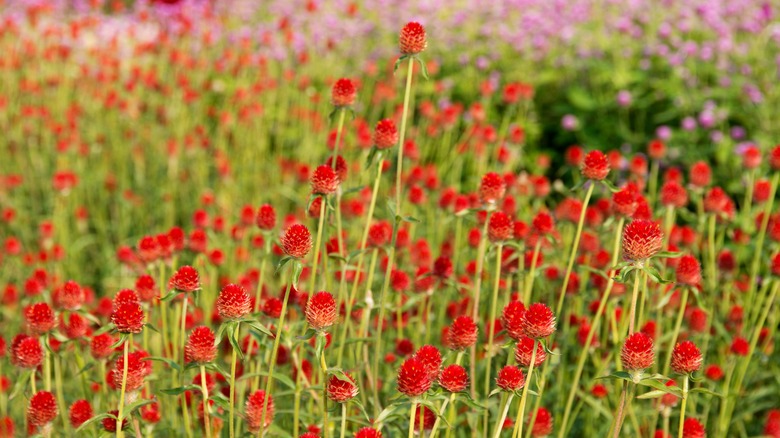This Easy-To-Grow Flower Is The Perfect Addition To Your Summer Garden
The bright sun and high heat of midsummer can be a drain on plants — scorched leaves and drought-induced wilting are all-too-common sights when temperatures soar. But if you're determined to overcome the odds and make your garden's summer color last well into fall, you can choose your flowers wisely to ensure continuous blooms throughout even the hottest months. One flower that will bloom all summer and even self-seed to effortlessly cover your backyard is Gomphrena globosa, or globe amaranth.
The blooms of globe amaranth resemble compact, spiked pom-pom balls, and come in a variety of colors, including magenta, pink, white, red, and yellow. There's even a variety called "Fireworks" because the yellow tips of the amaranth's fuchsia petals resemble sparklers or exploding fireworks. Globe amaranth grows 1 to 2 feet tall, making it a perfect addition to a summer border garden for a lasting pop of color. But globe amaranth doesn't stand out in a summer garden for its color alone — it has a few key qualities that make it perfect for weathering the worst of summer's heat, too.
A summer-proof flower
We all slip up sometimes when it comes to summer watering — whether it's leaving for a week's vacation or simply getting caught up in the busy rush of fun activities, there are plenty of distractions that might make watering your garden a forgotten item on your to-do list. Even with consistent watering, the recent span of the hottest summer months on record makes it difficult to provide 24/7 garden support. Luckily, globe amaranth is well-suited for this particular challenge – though it prefers consistent moisture (like most plants), it is very drought-tolerant once mature. It also thrives with full sun and generally tolerates heat well.
Globe amaranth's long blooming window — from June to first frost — and flexible sowing time also makes it a good choice for summer gardens, even if you don't get an early spring start to your growing period. Globe amaranth's hardiness range encompasses most of the continental U.S., and seeds can be sown as early as April (in zone 9) or as late as September (in zones 8 and 9). In all of the zones in which globe amaranth is hardy in the U.S., it can be planted throughout June, July, and August. This makes globe amaranth a good candidate for filling in garden spots that have died off as summer progresses.
How to grow globe amaranth
On top of being practically summer-proof, globe amaranth is extremely easy to grow from seed. Plant globe amaranth in containers or direct-sow after last frost in well-draining, average soil. If you want to maximize your globe amaranth blooms from early spring through to fall, you can also start globe amaranth seeds six to eight weeks before the last frost and transplant accordingly. Take care not to overwater globe amaranth, and position your plantings in full sun.
Globe amaranth does well as part of a mass planting and can be cut for fresh arrangements or dried before it fully blooms, in which case it will retain its bright color well. Maintenance is pretty low for globe amaranth, as it doesn't tend to have many pest problems, but blooms can be pinched early on to encourage bushy growth, and any taller plants may require stakes for support. Other than these few small care considerations, you can more or less sit back and relax while your globe amaranth carries your garden through the summer months!


